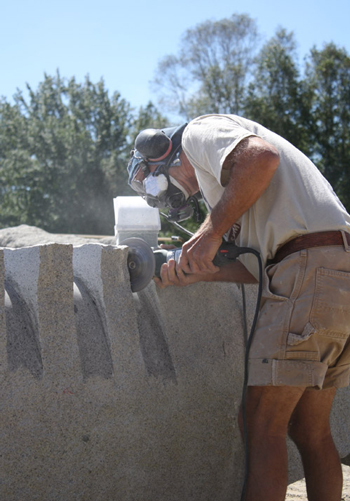Granite Sculpting Program at Schoodic In Third Year
by Fishermen’s Voice Staff

John Barlow Hudson, Ohio here carving Jonesboro Red granite. His sculpture will be going to Hancock, Maine. Hudson has works around the country and the world. From Maine he goes on to three projects this year including one in Dallas, Texas. Photo by Kayla Crowe
Six international sculptors were finishing monumental granite sculptures in Gouldsboro in August. The finished sculptures are scheduled for installation in Maine coastal towns in September. The Schoodic Sculpture Symposium, an independently funded program, has gained international recognition and is the largest public art project in the United States.
The large works, carved from various types of Maine granite by professional artists, are completed in six weeks. The sculptors, selected from 160 applicants, visit the site where their sculpture will be installed and design a work for that location.
The six sculptors working this year are: Lise Becu, Tenants Harbor, Maine; Jim Boyd, New Brunswick, Canada; Jorg Pickat, Hamburg, Germany; Hitoshi Tanaka, Japan; John Barlow, Ohio; Kazumi Hoshino, Steuben, Maine.
The Symposium was started three years ago by Maine sculptor Jessie Salsbury of Stuben and a group of Maine artists. Communities interested in having a sculpture in their town do fund raising for one quarter of the cost, or about $10,000 and the Symposium raises the balance through grants, public funds and private donations. None of the funding comes from the town’s tax revenues.
The funding mechanism, said Salsbury, is a complex network that results in sculptures being produced at about 40% of their commercial value and the towns get the public sculptures at about one quarter of that cost.
Salsbury went to high school in Japan when his father, fisherman Jim Salsbury, was a United States fisheries attaché there. It was in Japan that Jesse became interested in stone carving.
The sculptors are paid considerably less for sculptures done for symposia. However, the symposium atmosphere is not competitive and the artists help each other and socialize. This is in contrast to the higher paying, higher stress production of a sculpture for a corporate headquarters for example.
The program is a link to Maine’s granite quarrying industry, which was the largest in the nation 120 years ago. Massive quantities of granite were cut along the Maine coast and loaded onto sailing ships that took it to Boston, New York and Philadelphia. Hundreds of European and American stone carvers worked in Maine’s coastal quarries cutting precision building blocks and carving ornamental details for some of America’s most famous buildings. With the development of concrete in the early 1900’s granite construction faded as concrete skyscrapers rose.
The Symposium’s sculptures are monumental in size, but they are not monuments as were 19th century public sculptures. Rather than a general on a horse or a Greek deity, the Schoodic Symposium sculptures are universal images that are not literally or specifically associated with the town where they are installed.
The Schoodic Symposium has attracted some of the worlds most highly regarded sculptors. Many have decades of professional life behind them and dozens of works in countries around the world.
Granite for the sculptures is donated by local granite quarry companies. The work site is in Gouldsboro this summer. The work area is filled with the sound of cutting tools, a maze of compressed air lines on the ground, granite dust clouds and chunks of waste granite. The site is expected to move back to it’s original site on the Schoodic Peninsula in neighboring Winter Harbor when renovations are completed there.
See 2011 Schoodic International Sculpture Symposium to view more photographs.
